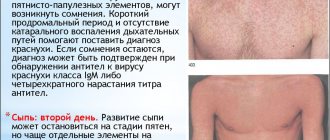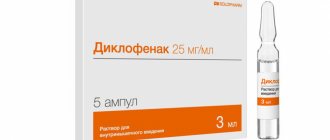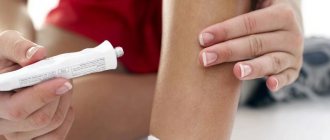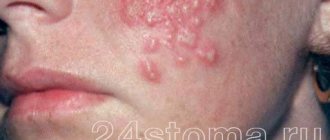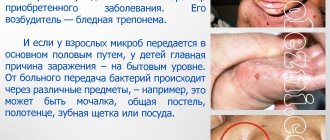Questions:
- What is pyoderma?
- Causes of pyoderma
- Symptoms
- Types of pyoderma
- How is pyoderma transmitted?
- Chronic pyoderma
- Pyoderma in children
- Pyoderma in newborns
- Treatment of pyoderma
- Is it possible to treat pyoderma at home?
- At what age can Timogen cream be used in children?
- Treatment with folk remedies
- Prevention
Medical specialists answer frequently asked questions from users
What is pyoderma?
Pyoderma is a disease of purulent skin lesions, most often caused by pyogenic (pyogenic) cocci - streptococci and staphylococci, which are constantly found on the skin and mucous membranes. In addition to these pathogens, there are other microorganisms on human skin, such as pseudodiphtheria bacillus, yeast-like fungi, etc., which can also cause disease under certain conditions. The name of the disease comes from the Greek py'on - pus and de'rma - skin). This is one of the most common skin diseases.
to the begining
Diagnostics
To diagnose pyoderma, the doctor first examines the rash and determines its nature. Then the discharge from the purulent areas is examined under a microscope. If the tissue damage is very severe, a biopsy is often prescribed.
Additionally, the doctor may recommend a blood test to exclude diabetes, control leukocytes and ESR.
When making a diagnosis, cutaneous forms of tuberculosis and syphilis, as well as various fungal, parasitic and other skin lesions that are not related to pyoderma, are excluded.
Causes of pyoderma
Frequent causes of pyoderma are hypothermia and overheating of the body under production conditions.
When the body cools, blood circulation is disrupted, swelling of the skin occurs, sebum secretion and sweating decrease, as a result, the skin becomes dry and flaky, making it easily susceptible to injury and infection.
Overheating of the body leads to loss of water and chlorides (mineral salts), the latter affecting the vascular system and the functions of the kidneys and skin.
The possibility of pyogenic infection can be increased by additional irritants like oils and other contaminants.
The skin is able to destroy microorganisms that fall on its surface due to the acidity of the skin (pH), the so-called “acid protective coat of the skin.” Bacterial infection occurs faster in those areas of the skin where the pH is higher - these are the armpits, interdigital folds of the feet, and inguinal folds. Therefore, pathological changes occur more often in these places.
to the begining
Treatment of pyodermatitis in adults with immunotherapy
Immunotherapy is a method of treating pyodermatitis using drugs that stimulate the body's immune response to the effects of certain pathogenic microorganisms. Immunotherapy is prescribed for the chronic course of pustular disease with exacerbations of pyodermic lesions at least once every 3-4 months. Before prescribing a course of immunotherapy, the patient undergoes an immunogram, which allows one to evaluate the main characteristics of the patient’s immune system.
For the treatment of pyodermatitis in adults, the following immunological drugs can be used:
- Staphylococcal toxoid is a drug that promotes the formation of immunoglobulins (specific immune cells) that neutralize staphylococcus;
- Staphylococcal vaccine: this medicinal product has immunomodulatory and antimicrobial properties. The effect of the vaccine is to increase the number of immunoglobulins, which effectively resist infection, as well as stimulate the immune system;
- Staphylococcal bacteriophage is a specific virus that, penetrating into the cells of a staphylococcal infection, promotes their destruction;
- Streptococcal bacteriophage is a virus that destroys the cells of streptococcal bacteria;
- Leukinferon is a drug that contains interferon, which has immunostimulating properties. It enhances the immune system's response by affecting various immune cells;
- Streptococcal vaccine is a drug that activates the body's immune system to fight streptococcal infection.
Kinds
Superficial staphyloderma
The most common are folliculitis, sycosis vulgaris, ostiofolliculitis, and epidemic pemphigus of newborns. Ostiofolliculitis is an abscess surrounded by a zone of mild hyperemia, penetrated by hair. With folliculitis, the abscess is located against the background of a painful bluish-pink nodule. Vulgar sycosis is called multiple, recurrent ostiofolliculitis and folliculitis against the background of thickened bluish-pink skin, often in the mustache and beard area. Epidemic pemphigus of newborns is a severe, contagious disease of the first days of life. In addition to the palms and soles, the child’s skin becomes covered with large blisters, which later form crusts and extensive erosions.
Deep staphyloderma
The most famous are boils, carbuncles, and hidradenitis. The boil develops from ostiofolliculitis or folliculitis. First, a painful node appears in the thickness of the skin, which enlarges; a large pustule is formed in its center, which opens with the subsequent separation of the purulent-necrotic core. After which, the resulting ulcer gradually scars.
A carbuncle is several boils located in one place, closely adjacent to each other, against the background of a general dense, edematous infiltrate of a bluish-purple color. The deep ulcer formed after opening the carbuncle heals with a rough scar. Hidradenitis is a purulent inflammation of the apocrine sweat glands, often recurrent. In the armpits, anogenital area, and around the nipples of the mammary glands, deep, painful nodes appear, over which the skin is colored bluish-pink. The nodes are opened with the release of liquid pus.
Superficial streptoderma
The most common is streptococcal impetigo . This disease occurs more often on the face in children and young women. Against the background of slightly hyperemic skin, phlyctens (bubbles with opalescent contents) appear, shrinking into yellowish crusts or eroding. When staphylococci are attached, the crusts become greenish-yellow or sometimes hemorrhagic ( impetigo vulgaris ). Without treatment, the disease can affect large areas of the skin. Lichen simplex , more often in children, is an abortive form of streptococcal impetigo. It is expressed by the appearance of whitish or light pink, slightly flaky spots.
Deep streptoderma
Vulgar ecthyma . With this disease, deep pustules appear, shrinking into purulent-bloody crusts, under which ulcers are found. After 2-3 weeks, the ulcers heal.
to the begining
Material and methods
At the screening stage, 55 patients were observed. Before prescribing systemic therapy, all patients underwent bacterial culture for sensitivity to minocycline
. After the study, sensitivity was detected in 46 (83.6%) patients, who made up the observation group.
Subsequently, 46 patients aged from 18 to 67 years were under our observation - 24 (52.2%) men and 22 (47.8%) women. In 25 (54.3%) patients, the process arose for the first time (duration up to 2 months) and was of an acute inflammatory nature, in 21 (45.7%) it lasted more than 2 months (chronic inflammation). The following clinical forms of pyoderma were diagnosed: vulgar impetigo - 6 (13%) cases, boils - 10 (21.7%), periungual phlyctena - 9 (19.6%), pyoderma of large folds - 11 (23.9%), erysipelas - 10 (21.7%) (Fig. 1).
Rice. 1. Clinical forms of pyoderma in patients under observation.
Initial dose of Minolexin
was 200 mg (2 capsules of 100 mg or 4 capsules of 50 mg), then patients took 100 mg (1 capsule of 100 mg or 2 capsules of 50 mg) every 12 hours (2 times a day). The drug intake was independent of food intake. The duration of antibiotic therapy was 7 days, for erysipelas - 10 days. Depending on the severity of the process, patients used aniline dyes and antiseptic drugs as topical therapy.
Pyoderma in children
Pyoderma in children most often develops due to parents' failure to comply with the hygiene regime. That is, parents do not wash their hands before touching the child, wash the child poorly or rarely, the child’s clothes are poorly washed and not ironed, and their clothes are rarely changed. In rare cases, also if hygiene rules are not followed, it is possible for a child to become infected from relatives who have foci of chronic infection - carriers of staphylococci, streptococci, people with reduced immunity (patients with diabetes, alcoholism, old people, cancer patients).
to the begining
Risk factors
The etiology of pyoderma is not limited to the mechanisms of formation of the purulent-inflammatory process. Dermatologists know the forms of predisposition to this disease associated with lifestyle, heredity and the patient’s individual history.
Known risk factors:
- Failure to comply with personal hygiene rules. Constant skin contamination increases the risk of infection.
- Overheating or hypothermia of integumentary tissues. Temperature changes disrupt the functions of local immunity. Often, after hypothermia, the skin becomes a gateway to infection.
- Age. In newborns and the elderly, pyoderma most often occurs due to insufficient effectiveness of local immunity.
- The presence of a large number of allergic reactions and autoimmune diseases (especially in children.)
- Pathologies of the endocrine system. The condition of the skin largely depends on hormonal influences.
- Metabolic diseases: diabetes and obesity.
- Congenital and acquired immunodeficiency conditions.
- Poor nutrition leading to a deficiency of certain vitamins and microelements in the body.
- Unfavorable family heredity. Skin diseases may be associated with the transmission of genetic mutations.
The causative agents of pyoderma dermatitis are found in the environment and on the surface of the integumentary tissue. These are staphylococci, streptococci and some pathogenic fungi. People often become infected with pyogenic bacteria in a hospital setting.
Pyoderma in newborns
Pyoderma in newborns most often occurs due to nosocomial infection, violation of the rules of child care and in weakened, premature children. Common pyoderma in newborns is called bullous impetigo, it is life-threatening and progresses very quickly; treatment is carried out only in a hospital. Red rashes appear on the skin, which quickly turn into hyperemia of the entire skin; detachment of the epidermis occurs with the formation of large blisters and crusts. When an infection gets into the umbilical wound, inflammation develops - omphalitis, which can quickly develop into umbilical sepsis. Symptoms of omphalitis: pus from the umbilical wound and an unpleasant odor, swelling and redness of the edges of the wound and the skin around it, increased body temperature, refusal to eat, anxiety.
to the begining
Prevention
Preventing infectious and inflammatory skin diseases on your own is not a difficult task.
Basic methods of prevention:
- hygienic skin care;
- timely treatment of cuts and burns;
- treatment of chronic infections;
- regular examinations by a dermatologist for chronic skin diseases;
- control blood sugar levels in diabetes.
Consultation with a dermatologist and immunologist will help the patient learn more about methods of prevention and treatment of pyoderma.
Treatment
- Treatment in children
Treatment of omphalitis is carried out only by a doctor. In the initial stage, local use of medications is possible: washing the wound with a solution of hydrogen peroxide, treatment with brilliant green, iodine solution, methylene blue solution and various local antimicrobial drugs. Treatment of pyoderma in children involves the use of broad-spectrum antibiotics, infusion therapy, and immunomodulators. In the initial stages of pyoderma, it is possible to treat pyoderma with local means - solutions of boric and salicylic acids, sanguiritin, eucalymin, tomicide, cyminal and others in the form of solutions, lotions, under a bandage. See also our specialist’s answer to the user’s question: Pyoderma in children, how to cure it? - Treatment in adults
In adults, pyoderma is also treated by a doctor. For mild pyoderma, local medications are used (see above); for moderate severity, broad-spectrum antibiotics and sulfonamides are added to local treatment.To increase the body's resistance in the treatment of pyoderma, the immunomodulatory drug Thymogen is used. These are Thymogen cream, which is applied to the affected areas, and Thymogen solution for injection.
to the begining
conclusions
Thus, Minocinclin
has a wide spectrum of antimicrobial action, high bacteriostatic activity against infections sensitive to it, a minimum of side effects and a convenient dosage regimen.
Consequently, the drug meets modern requirements for rational antibiotic therapy and can be recommended in clinical practice for the effective treatment of various clinical forms of pyoderma. Recommended course: the initial dose of Minolexin
was 200 mg (2 capsules of 100 mg or 4 capsules of 50 mg), then 100 mg (1 capsule of 100 mg or 2 capsules of 50 mg) every 12 hours (2 times per day).
Taking the drug does not depend on food intake. The duration of antibiotic therapy is 7 days, for erysipelas - 10 days. The drug has a good safety profile, which is confirmed by the absence of significant negative dynamics in clinical blood and urine tests and biochemical blood tests. Minocycline
is characterized by high lipophilicity and dermatotropism, allowing it to achieve optimal therapeutic concentrations inside the inflammatory elements of the skin and the absence of increased photosensitivity .
The authors declare no conflict of interest.
1e-mail 2e-mail
Can it be treated at home?
- First of all, it is necessary to establish the nature of pyoderma. In other words, identify the causative agent of the disease and determine its sensitivity to antibiotics. After a course of antibacterial therapy (local use of antibacterial drugs in most cases is ineffective) against the background of normal multivitamin-mineral support (taking vitamins), such diseases usually go away. But pyoderma, as a rule, develops against the background of reduced immunological resistance or is provoked by diseases of the internal organs: stomach, intestines, liver, pancreas. Therefore, an in-depth examination is necessary.
to the begining
Nutrition during an exacerbation
Nutrition plays an important role in the treatment of various forms of pyoderma. The basic principles of diet during an exacerbation of the disease can be described as follows:
- Meals should be regular.
- Complete in composition of proteins, fats, carbohydrates and vitamins.
- The amount of salt in food is sharply limited (up to 5 g).
- The amount of carbohydrates is reduced.
- Alcohol is completely excluded.
- Any products that can provoke allergies are excluded (for this, an allergy history is carefully collected).
- The drinking regime is controlled; it is necessary to consume at least 1.5 liters of liquid.
The diet includes low-fat fermented milk products; fresh vegetables, herbs; lean boiled meat and fish; durum wheat pasta; boiled eggs; olive and linseed oils; buckwheat grain; bran.

